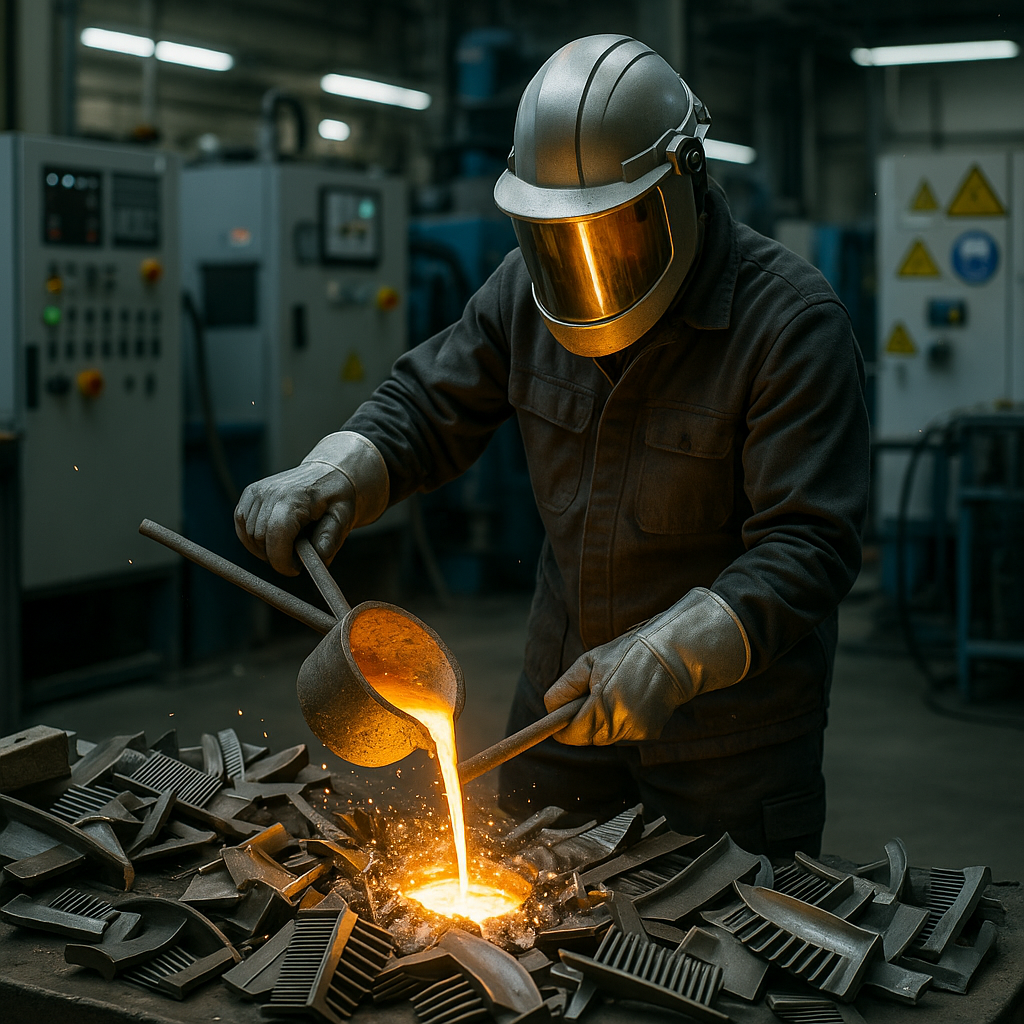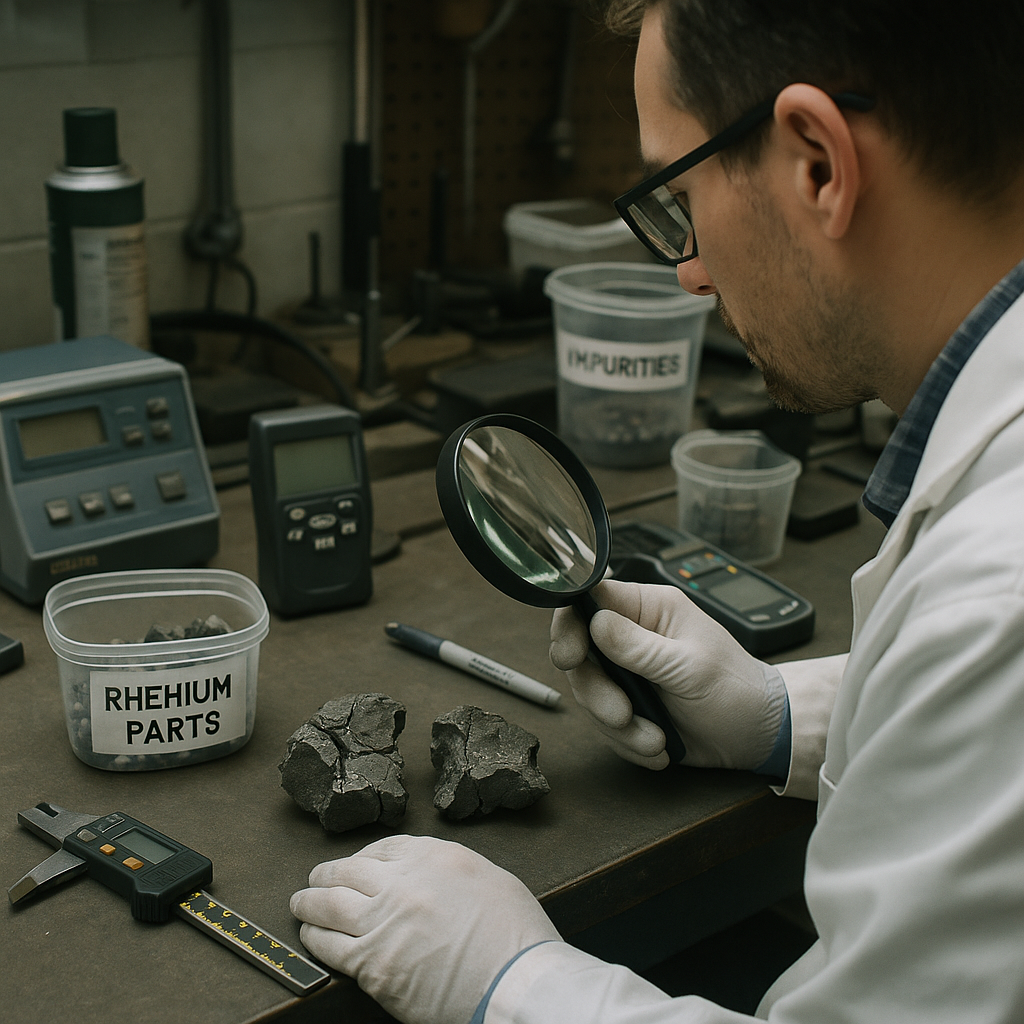5901 Botham Jean Blvd, Dallas, TX 75215
Rhenium Recycling Process: Sources, Techniques & Challenges
October 28, 2025Rhenium, one of the rarest elements in the Earth’s crust, with an average concentration of less than one part per billion, has become vital to modern transportation and energy production. This silvery-white metal possesses exceptional heat resistance with a melting point of 3,180°C and remarkable wear resistance, making it indispensable in high-performance applications.
The rhenium recycling process involves recovering and extracting this valuable metal from secondary sources rather than mining it from primary ores. These secondary sources primarily include spent superalloys (containing 3-6% rhenium) from aircraft turbine blades, used platinum-rhenium catalysts from petroleum refining, and manufacturing scrap like sputtering targets and punching waste.
The recycling process typically combines two main metallurgical approaches: pyrometallurgical techniques, which use high temperatures to transform metal-containing materials, and hydrometallurgical methods, which employ aqueous solutions to separate and concentrate the rhenium. This multi-step process aims to efficiently recover high-purity rhenium in forms suitable for industrial reuse, most commonly as ammonium perrhenate (NH₄ReO₄)—a white powder that serves as the principal form for marketing rhenium.
What are the Main Sources of Recyclable Rhenium?

Recyclable rhenium primarily comes from two sources: spent superalloys and catalysts. As one of the Earth’s rarest elements with limited primary reserves, recycling rhenium is increasingly important for maintaining a sustainable supply chain in critical industries.
Superalloys represent the richest source of recoverable rhenium. These specialized materials, used extensively in aerospace and industrial gas turbines, contain 1% to 20% rhenium by weight. Common nickel-based superalloys have 3-6% rhenium, enhancing their high-temperature properties and creep resistance. Turbine blades and vanes from aircraft engines and power generation applications are particularly valuable for rhenium recovery due to their sufficient quantities, making recycling economically viable. The life cycle of these components is approximately 10 years, providing a steady stream of recyclable material.
Spent catalysts from the petrochemical industry are the second major source of recyclable rhenium. Platinum-rhenium catalysts are used in oil refineries to produce high-octane, lead-free gasoline through catalytic reforming processes. Although their rhenium content is about 0.3% by weight, the large volume of catalysts processed makes them a significant source for recovery. Most catalyst recycling occurs in a closed-loop system, where the recovered rhenium is returned to oil companies or catalyst producers for manufacturing new catalysts.
Other valuable sources include specialized alloys used in high-temperature applications. Tungsten-rhenium and molybdenum-rhenium alloys, which contain 3-5% rhenium, are used in industrial applications requiring exceptional heat resistance, such as electrical contact points, heating elements, thermocouples, X-ray tubes and targets, and other specialized equipment. Rhenium enhances these materials by reducing brittleness, increasing recrystallization temperature, and improving ductility and tensile strength.
| Source | Rhenium Content (wt%) |
| Ni-Re Superalloys | 1–20 wt% (commonly 3–6 wt%) |
| W-Re and Mo-Re Alloys | 3–5 wt% |
| Spent Catalysts | ~0.3 wt% |
Recovery methods for these materials vary based on their composition. Superalloys typically undergo hydrometallurgical processing to extract rhenium, although some facilities use pyrometallurgical techniques. For many aerospace components, processors may opt to generate high-quality engine revert—a superalloy meltstock that retains rhenium—rather than separating the individual metals. This process is less costly and quicker than complete separation.
The economic viability of rhenium recycling depends on several factors, including the rhenium content of the scrap material and market prices. Materials with less than 1% rhenium are generally considered uneconomical to recycle through complete separation processes. Nevertheless, with primary rhenium resources expected to deplete within the next century, the importance of these secondary sources continues to grow. Currently, approximately 10 tons of rhenium is recycled annually worldwide, with recycling operations concentrated in Canada, Germany, the United States, Estonia, France, Poland, and Russia.
How is Rhenium Recycled from Superalloys?

Rhenium recycling from superalloys has gained significance due to the metal’s scarcity and high value. These superalloys typically contain 3-6% rhenium by weight, making them a key secondary source for this rare metal. The recycling process primarily involves two methods: pyrometallurgical and hydrometallurgical.
Pyrometallurgical processes use high temperatures to recover rhenium. In this method, superalloy scrap is heated to temperatures between 800°C and 1200°C in an oxidizing atmosphere, converting rhenium into its volatile oxide form (Re₂O₇), which evaporates from the mixture. The gaseous oxide is then condensed in a controlled environment and collected for further processing into metallic rhenium or other compounds.
Hydrometallurgical processes operate at lower temperatures, using chemical reactions in aqueous solutions. This method begins with acid leaching, where superalloy scrap is treated with solutions like hydrochloric acid, enhanced with oxidizing agents. The acid dissolves rhenium along with other metals. Following leaching, selective separation techniques isolate rhenium from the solution.
Several separation methods can be employed in the hydrometallurgical process. Solvent extraction uses organic solvents to selectively extract rhenium from the leach solution. Ion exchange resins can capture rhenium ions while allowing other metals to pass. After separation, the rhenium-rich solution undergoes crystallization to form compounds like ammonium perrhenate, which can be further processed into pure rhenium metal.
Some advanced recycling operations combine both approaches into hybrid pyro-hydrometallurgical processes. These typically start with high-temperature treatment in a salt melt to break down the superalloy structure, followed by leaching and separation to recover rhenium. This combined approach maximizes metal recovery while minimizing energy consumption.
Selecting between pyrometallurgical and hydrometallurgical methods depends on various factors. Pyrometallurgical processes offer higher processing capacity and are effective with mixed scrap materials. However, they are energy-intensive and may result in rhenium loss through incomplete volatilization. Hydrometallurgical methods provide more selective recovery with higher purity products, but they produce more waste that requires treatment.
Recent advancements focus on improving efficiency in both methods. Researchers are exploring electrochemical techniques to enhance leaching, developing more selective extraction agents, and optimizing process parameters to increase rhenium recovery rates from superalloy scrap.
| Source | Typical Rhenium Content (%) |
| Superalloys | 3-6% |
| Catalysts | 0.3% |
| Tungsten-Rhenium Alloys | 3-5% |
| Molybdenum-Rhenium Alloys | 3-5% |
| Method | Advantages | Disadvantages |
| Pyrometallurgical | High capacity, suitable for mixed materials | High energy consumption, potential losses |
| Hydrometallurgical | High purity, more selective recovery | Generates more waste |
| Technique | Role |
| Roasting | Transforms rhenium into volatile oxide |
| Solvent Extraction | Selective rhenium extraction |
| Ion Exchange | Concentrates rhenium |
| Source | Recovery Approach |
| Superalloys | Hydrometallurgical or Pyrometallurgical |
| Catalysts | Pyrometallurgical followed by Hydrometallurgical |
The economic viability of rhenium recycling continues to improve as prices rise and technologies advance. With natural rhenium resources expected to deplete within decades, efficient recycling from superalloys is crucial for sustainable supply chains of this strategic metal.
What Techniques are Used to Recycle Rhenium from Catalysts?
Recycling rhenium from spent catalysts employs advanced processes to efficiently recover this valuable metal. Spent catalysts from petroleum refining typically contain around 0.3 wt% rhenium alongside platinum on an alumina carrier. Despite these seemingly small concentrations, they represent a significant recovery opportunity, containing substantially higher rhenium content than primary ores.
Pyrometallurgical Processing: Roasting and Volatilization
The recycling process often begins with a pyrometallurgical approach. Spent catalysts undergo roasting at high temperatures in an oxidizing atmosphere. This crucial step transforms rhenium into rhenium oxide (Re₂O₇), a volatile compound that can be separated from other materials.
Once volatilized, the rhenium oxide is recovered through condensation in specialized collection systems. This captured oxide is then dissolved in water, creating a rhenium-bearing solution for further processing. Volatilization is particularly effective because it leverages rhenium’s unique ability to form gaseous oxides at elevated temperatures.
Hydrometallurgical Techniques for Further Processing
Following the initial pyrometallurgical steps, hydrometallurgical processes purify the rhenium solution. These techniques include acid leaching, where sulfuric or hydrochloric acid solutions solubilize remaining rhenium compounds. Selective dissolution methods help separate rhenium from other metals present in the catalyst residue.
Separation and concentration of rhenium from solutions typically involve solvent extraction or ion exchange. In solvent extraction, specific organic extractants bind with rhenium ions, allowing them to transfer to an organic phase for recovery. Ion exchange uses specialized resins to attract rhenium ions from the solution, effectively concentrating the metal for recovery.
Selective Pressure Leaching with Ammonium Halogen Salts
An innovative approach to rhenium recovery involves selective pressure leaching using ammonium halogen salts. This method uses compounds such as ammonium iodide or bromide combined with oxygen and sulfuric acid under elevated temperatures and pressures. This technique is particularly valuable as it can simultaneously extract rhenium and platinum group metals from the catalyst material.
The selective nature of this process helps minimize the co-extraction of less valuable metals, improving the efficiency of downstream purification steps. After leaching, rhenium can be recovered from the solution through methods like cementation, further solvent extraction, or electrowinning.
Alternative Approaches and Innovations
Some recycling operations use sodium bicarbonate dissolution, achieving up to 97% recovery of rhenium in initial stages. This is often followed by sulfuric acid leaching to extract any remaining platinum and aluminum from the catalyst material.
Another approach uses caustic dissolution with sodium hydroxide, though this method faces challenges in effectively retrieving all available rhenium. Recently, electrochemical processes have been developed to enhance rhenium recovery rates.
Each recycling method offers different advantages in terms of recovery efficiency, environmental impact, and cost-effectiveness. The optimal technique often depends on the specific catalyst composition and available processing infrastructure.
| Recycling Technique | Method | Advantages | Challenges |
|---|---|---|---|
| Pyrometallurgical Processing | Roasting and Volatilization | Effective volatilization of rhenium oxide | Energy intensive |
| Hydrometallurgical Techniques | Acid Leaching and Solvent Extraction | High recovery purity | Produces waste streams |
| Selective Pressure Leaching | Use of Ammonium Halogen Salts | Simultaneous extraction of rhenium and PGMs | Process complexity |
What are the Challenges in Rhenium Recycling?

Despite its economic and environmental advantages, rhenium recycling faces significant challenges. Recovering this rare metal requires specialized expertise and processes to ensure efficiency and sustainability.
Collection and Classification Challenges
Efficiently collecting and classifying rhenium-containing materials is a primary challenge in rhenium recycling. Rhenium is found across various industrial sectors in different forms and concentrations, complicating systematic collection efforts.
The accurate identification and sorting of rhenium-bearing scrap are crucial yet difficult tasks. Materials range from superalloys with 3-6% rhenium content to catalysts with about 0.3% rhenium. This variation demands sophisticated classification systems that many recycling operations currently lack.
Enhancing collection networks and employing advanced sorting technologies could greatly increase the volume of rhenium-containing materials entering the recycling stream. Improved coordination among aerospace, energy, and petrochemical industries would create more efficient recovery pathways.
Technical Processing Challenges
The varying composition of rhenium-containing alloys and catalysts poses complex technical hurdles. Each material type demands specific extraction methods to effectively recover rhenium without significant losses.
Separating rhenium from other valuable metals in superalloys requires advanced processes, as the metal often exists alongside nickel, cobalt, and tungsten in complex matrices that are tough to break down efficiently. Current extraction methods can lead to material losses during processing.
Developing more selective extraction technologies is a crucial area for innovation. Advances in solvent extraction, ion exchange, and electrochemical processes are promising for enhancing both the efficiency and selectivity of rhenium recovery.
Economic and Integration Challenges
The economic feasibility of rhenium recycling varies with market prices and processing costs. Although the high value of rhenium makes recycling attractive, the required investment in specialized equipment and expertise can be prohibitive for smaller operations.
Integrating rhenium recycling processes into existing industrial systems is another significant challenge. Many facilities lack the infrastructure to recover this rare metal efficiently, resulting in valuable rhenium being lost to conventional waste streams.
Establishing cost-effective recycling pathways necessitates collaboration between material suppliers, manufacturers, and recyclers. Creating closed-loop systems, where rhenium-bearing materials are tracked from production through end-of-life, could dramatically improve recovery rates.
Environmental Sustainability Concerns
Ensuring that rhenium recycling processes are environmentally sustainable presents additional challenges. Traditional extraction methods may involve harsh chemicals and energy-intensive processes that potentially offset recycling’s environmental benefits.
Developing greener processing technologies is vital for truly sustainable rhenium recycling. Promising approaches include bio-hydrometallurgical processes and energy-efficient pyrometallurgical techniques, which reduce the environmental footprint of rhenium recovery.
Balancing recovery efficiency with environmental impact requires ongoing research and development. Achieving this balance is essential for making rhenium recycling a sustainable alternative to primary extraction.
| Method | Approach | Features | Applications | Challenges |
|---|---|---|---|---|
| Electrolytic Decomposition | Hydrometallurgical | Involves low-frequency electrolysis using hydrochloric acid; Rhenium recovered via ion exchange | Superalloy scrap | Complex and requires precise control |
| Molten Salt Digestion | Pyrometallurgical | Uses sodium hydroxide and sodium sulfate; Suitable for high-temperature treatment | Superalloy scrap | High energy consumption |
| Electrochemical Process | Hydrometallurgical | Leaching with sulfuric/nitric acids; Produces Re concentrates through crystallization | Superalloy scrap | Loss of rhenium in solution |
| Roasting and Volatilization | Pyrometallurgical | Rhenium oxidized to volatile Re2O7 | Spent catalysts | Requires high temperatures |
| Sulfuric Acid Leaching | Hydrometallurgical | Uses sulfuric acid for selective metal dissolution | Spent catalysts | Potential environmental impact |
Future Directions for Rhenium Recycling
Tackling these challenges demands coordinated efforts across the rhenium value chain. Industry stakeholders are increasingly aware of the strategic importance of developing more efficient recycling technologies to secure the rhenium supply.
Research into selective separation technologies is promising for overcoming current limitations. Advanced membrane technologies, specialized adsorbents, and innovative extraction methods could transform the economics and efficiency of rhenium recycling.
Ultimately, the future of rhenium recycling hinges on viewing challenges as opportunities for innovation. With the right investment and research focus, many current obstacles can become competitive advantages in the circular economy for critical materials.
Conclusion: The Future of Rhenium Recycling

Rhenium recycling is a crucial element in maintaining a sustainable supply of this exceptionally rare and valuable metal. With primary resources likely to deplete within the next century, recycling rhenium from secondary sources is not only environmentally responsible but also economically necessary. Current recycling efforts recover about 10 tons of rhenium annually, demonstrating these processes’ viability. However, further optimization is needed.
The future of rhenium recycling will hinge on innovations in separation techniques, enhancements in process efficiency, and the development of more environmentally friendly methods. As demand in the aerospace and energy sectors continues to rise, these technological advancements will be vital in bridging the gap between limited natural resources and increasing market needs. The advent of more efficient hydrometallurgical and pyrometallurgical techniques will likely transform rhenium recovery from superalloys, catalysts, and other secondary sources.
For organizations aiming to manage their rhenium-containing materials responsibly and support a sustainable supply chain, contact Okon Recycling at 214-717-4083. Our specialized recycling solutions can help turn waste streams into valuable resources, advancing global sustainability goals.
